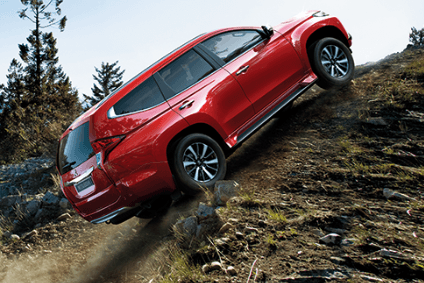
Already produced in two Thai plants and from next year, in Indonesia as well, the Pajero Sport is becoming an increasingly important model for Mitsubishi’s global SUV line-up.
The latest model, which went on sale in its first market in the final quarter of 2015, is already an in-demand vehicle. Mitsubishi has three plants in Thailand and the Pajero Sport is built at Laem Chabang Factory #1 and Factory #2. This is also where the Triton/L200 is made, which is no coincidence, given that both models share a basic architecture. Which of course means the Pajero Sport is a body-on-frame design.

Discover B2B Marketing That Performs
Combine business intelligence and editorial excellence to reach engaged professionals across 36 leading media platforms.
The ladder chassis platform was first seen in the previous generation Triton, and then updated for the launch of the current generation model in 2014. Like the pick-up, the Sport remains in rear-wheel drive for most of the time, but four-wheel drive, including high and several low range modes – 2H, 4H, 4HLc, 4LLc – can be activated from a circular controller located behind the gear lever.
The whole interior is not dissimilar to that of high-end Triton model grades and is a big improvement on the previous shape model, which was called Challenger or Nativa in some markets. Incidentally, European sales are expected to commence from year-end, which should mean Montero Sport in Spain, Shogun Sport in the UK and Pajero Sport in most other countries. As was the case with the old shape car, the new one won’t be available in North America, though: the US importer says the model would need to be widened to satisfy the country’s rollover laws.
On the outside, there are big differences between the pick-up and the SUV, with the Sport having an identity all of its own. Big chrome-effect inserts in the bumpers make for a highly distinctive front end and the long tail lights do the same at the rear. This shape is carried into the interior with matt-silver trim on the passenger door curving into the dashboard above the glovebox. You’ll find an abundance of shoulder, leg and head room, and in some markets, there is also the option of seven seats. Unlike the Pajero, with its swing-door, the tailgate is top-hinged. The boot’s capacity is an enormous 673 litres with the second row seats in the upright position or 1,624 litres when they’re folded.
Curiously, the word Mitsubishi appears nowhere on the exterior. On the left of the car’s rear is the model name, with the three diamonds in the centre of the tailgate as well as on the grille and in the wheel centres. When you start the car, Mitsubishi Motors illuminates on the centre screen and between the instruments. There’s a thick-rimmed four-spoke steering wheel, high-mounted vents and a seven-inch infotainment display. This is compatible with Apple Car Play and Android Auto.
There’s only one engine, a 133kW 2.4-litre diesel, which produces 430Nm of torque. While this is carried over from the Triton, the Pajero Sport is the first model for Mitsubishi’s own V8AWG eight-speed automatic gearbox.
The suspension system at the rear is also a bespoke arrangement for the Sport, with the Triton’s leaf springs ditched in favour of an independent set up. This makes all the difference when it comes to ride, with just the right mix of compliance, even on the typically abrasive and often poorly maintained surfaces of New South Wales roads. The steering is as good as if not better than some monocoque crossovers, with a lot of feel and none of the sloppiness which usually distinguishes ladder-frame SUVs. Mitsubishi says the 11.8 metre turning circle is the best in the segment.
As noted in the introduction, this model will one of the vehicles to be made at a plant in Indonesia which is presently under construction. Mitsubishi Motors Corporation (MMC) and Mitsubishi Corporation (MC) created a new joint manufacturing company, Mitsubishi Motors Krama Yudha Indonesia (MMKI), with local partner Krama Yudha (KY) to erect this factory at GIIC Industrial Estate, 37km east of Jakarta.
The new plant, with a production capacity of 160,000 units per year, will start operations in April 2017. In addition to the Pajero Sport, it will build the already locally-produced vehicles such as the Colt L300 light commercial plus a new small MPV (multi-purpose vehicle) model. A portion of those vehicles will be exported to other ASEAN countries. The plant is expected to play a very important role as the second largest production site for MMC vehicles in the ASEAN region, after the Laem Chabang complex.
Australia was one of the first markets where the Pajero Sport became available after Thailand. The roll out continues, with launches now taking place or soon to happen in selected ASEAN nations, countries in the Middle East, Africa, Latin America, then Russia and as noted earlier, Europe. The car will eventually be sold in some 90 countries. Its rivals include the Toyota Fortuner, Ford Everest/Endeavour and Isuzu mu-X.






